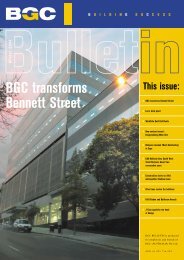Plasterboard & Cornice - BGC
Plasterboard & Cornice - BGC
Plasterboard & Cornice - BGC
You also want an ePaper? Increase the reach of your titles
YUMPU automatically turns print PDFs into web optimized ePapers that Google loves.
12<br />
Back Blocking<br />
Back blocking is used to reinforce unsupported butt or<br />
recessed joints and must be positioned midway between<br />
supporting members, in ceilings and walls.<br />
Position joint<br />
on centreline<br />
between ceiling<br />
joist or stud<br />
offset 50mm max<br />
<strong>BGC</strong> Ceilingboard<br />
<strong>BGC</strong> PLASTERBOARD & CORNICE - November - 2012<br />
Back blocking must be used in open areas of ceilings (back<br />
of recessed joints) with 3 or more joints and where there is<br />
a likelihood of excessive shrinkage and movement in the<br />
structure.<br />
<strong>BGC</strong> Ceilingboard 3mm deep depression at sheet joint<br />
Fill - following recessed joint instructions<br />
Black Blocking Procedure For Recessed Edge Joins<br />
(a) Cut back blocks at least 200 mm wide and long enough to<br />
fit between the framing members with a gap not greater than<br />
30 mm at each end.<br />
(b) Apply <strong>BGC</strong> Back Blocking Cement over the full face of<br />
the back block. A notched spreader providing 6 mm × 6 mm<br />
beads at approximately 20 mm centres at right angle to the<br />
joint would be satisfactory.<br />
(c) Fix the plasterboard to framing members.<br />
Back Blocking Procedure<br />
Recessed joint<br />
Bond back block to ceiling sheets<br />
with <strong>BGC</strong> Back Blocking Cement<br />
(Apply using notched spreader)<br />
Install temporary battern and packer to produce 3mm depression at joint.<br />
Leave in place for 24hrs minimum after bonding the back block<br />
<strong>BGC</strong> Ceilingboard back block<br />
<strong>Plasterboard</strong> back blocking<br />
at least 200mm width & centred<br />
overrecess joint<br />
<strong>BGC</strong> Ceilingboard<br />
back blocking<br />
(d) Place back blocks centrally along the full length of the<br />
board edge.<br />
(e) Immediately after the back blocks are in place,<br />
fix the next sheet.<br />
Alternatively, ceilings back blocks may be cemented into<br />
position from above the ceiling after the sheets have been<br />
fixed and before they are flush jointed.<br />
Framing or<br />
battens<br />
Back blocking cut to<br />
fit loosely between<br />
framing members















